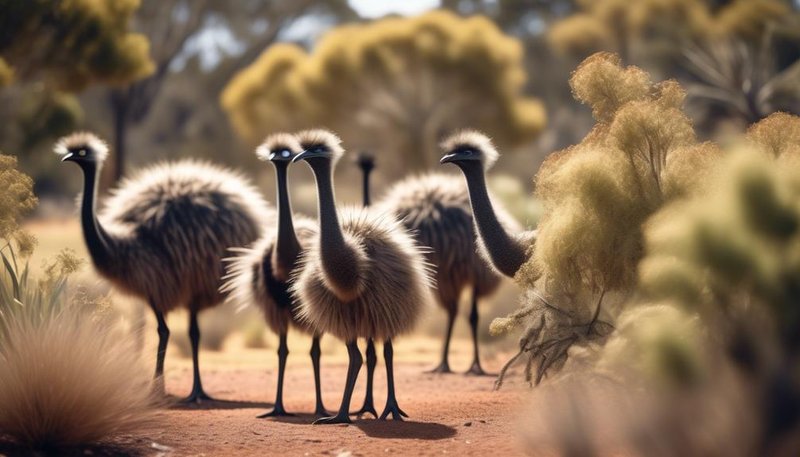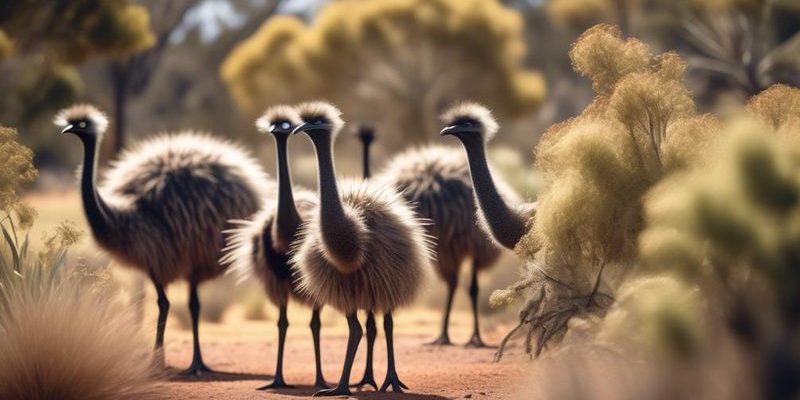
In this article, we’ll explore how emus fit into their natural habitat and the essential functions they perform within it. Think of them as the unsung heroes of the Australian outback, quietly working behind the scenes. From seed dispersal to influencing the growth of native flora, emus contribute to a balanced ecosystem. So, grab a cup of coffee and let’s dive into the importance of these fascinating birds!
Emus as Seed Dispersers
One of the most critical roles that emus play in their ecosystem is seed dispersal. When emus eat fruits and seeds, they travel considerable distances while digesting them. This natural process helps to spread plant life over a larger area. Imagine an emu munching on berries, then wandering off to a new location. As it walks, it scatters seeds through its droppings, enabling new plants to grow in different spots. This is essential for maintaining biodiversity.
Moreover, some plant species have developed adaptations specifically for this relationship. They produce large, fleshy fruits that attract emus. In return, the plants benefit from having their seeds transported far from the parent plant. It’s a win-win situation! Without emus, many plants may struggle to propagate, leading to less diverse ecosystems.
Influence on Vegetation Structure
Emus don’t just spread seeds; they also shape the structure of their habitat. As they forage for food, they can significantly impact the plant community. They tend to prefer younger, tender plants, which can help maintain a balance in plant growth. If emus are too numerous or absent, you’d see an overabundance of certain species, which can choke out others.
Additionally, their grazing habits can encourage new growth. When they nibble on grasses and shrubs, they promote the development of new shoots. This keeps the vegetation healthy, providing food and shelter for other animals. So, the humble emu has a hand in crafting a thriving environment for countless species.
Providing Food for Predators
In the food chain, emus are not just creators but also contributors to the ecosystem. They serve as prey for various predators, including dingoes and wedge-tailed eagles. When you think about it, the presence of emus supports these predators’ survival, adding another layer to the delicate balance of the ecosystem.
By providing a food source, emus help sustain local wildlife populations. If emus were to decline in number, it could create a ripple effect that disrupts the balance of the ecosystem. The loss of a single species can impact others, leading to unforeseen consequences. You might say that emus are an essential link in the food web that connects different wildlife.
Nesting and Habitat Creation
Emus also play a role in habitat creation through their nesting behaviors. When they lay eggs, they often choose sparse areas that can benefit from their presence. Their nesting sites may support certain ground cover plants that thrive in those particular conditions. It’s like a natural gardening effort, with emus shaping their environment to suit their needs while inadvertently supporting other organisms.
Also, when emus leave a nesting area, the disturbed soil may provide opportunities for new plant growth. This further enhances the diversity of plants in the region, which can attract numerous insects and small animals. These changes lead to a richer and more vibrant ecosystem.
Impact on Soil Health
Another often-overlooked benefit of emus is their contribution to soil health. When emus scratch at the ground for seeds and insects, they help aerate the soil. This is essential for soil health, as it allows for better water infiltration and root growth. Imagine if you’ve ever tried digging in compacted soil—it’s tough work! Emus naturally alleviate this issue by breaking up the ground as they search for food.
Their droppings also play a crucial role in fertilizing the soil. Filled with nutrients from their diet, emu droppings enrich the land, promoting the growth of healthy plants. Healthy soil leads to robust vegetation, which benefits not just emus but a whole host of other animals as well.
The Role of Emus in Cultural Ecosystems
Emus also have a cultural significance, particularly for the Indigenous peoples of Australia. For many communities, the emu symbolizes resilience and adaptability. They have been part of local lore and storytelling for generations.
This cultural connection highlights the emu’s role beyond the biological; it enhances the social and cultural fabric of the landscape. Respecting and understanding the emu contributes to conservation efforts. When people value a species for its ecological and cultural significance, they’re more likely to work toward protecting it.
Conservation and the Future of Emus
As we look toward the future, conserving emus and their habitats is vital. With habitat loss and climate change threatening their populations, efforts to protect these birds are crucial. By appreciating their roles in the ecosystem, we can better advocate for their conservation.
Here’s the thing: preserving emus isn’t just about saving a single species; it’s about maintaining a whole ecosystem. Healthy populations of emus support the survival of many other plants and animals. By investing in conservation initiatives, we’re taking a stand for the health of the entire ecosystem.
In conclusion, emus are more than just quirky birds wandering the Outback. They’re vital players in their ecosystem, influencing everything from plant diversity to predator dynamics. So, the next time you see an emu, think about all the important work it’s doing behind the scenes to keep the ecosystem balanced and thriving. Their role is a beautiful reminder of how interconnected life is in the natural world.

